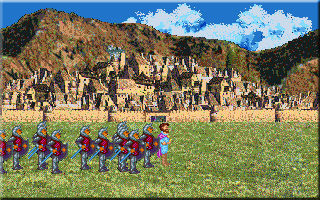
War in Middle-earth
Encyclopedia

Real-time strategy
Real-time strategy is a sub-genre of strategy video game which does not progress incrementally in turns. Brett Sperry is credited with coining the term to market Dune II....
game released for the ZX Spectrum
ZX Spectrum
The ZX Spectrum is an 8-bit personal home computer released in the United Kingdom in 1982 by Sinclair Research Ltd...
, Commodore 64
Commodore 64
The Commodore 64 is an 8-bit home computer introduced by Commodore International in January 1982.Volume production started in the spring of 1982, with machines being released on to the market in August at a price of US$595...
, Amstrad CPC
Amstrad CPC
The Amstrad CPC is a series of 8-bit home computers produced by Amstrad between 1984 and 1990. It was designed to compete in the mid-1980s home computer market dominated by the Commodore 64 and the Sinclair ZX Spectrum, where it successfully established itself primarily in the United Kingdom,...
, MS-DOS
MS-DOS
MS-DOS is an operating system for x86-based personal computers. It was the most commonly used member of the DOS family of operating systems, and was the main operating system for IBM PC compatible personal computers during the 1980s to the mid 1990s, until it was gradually superseded by operating...
, Commodore Amiga, Apple IIGS
Apple IIGS
The Apple , the fifth and most powerful model in the Apple II series of personal computers produced by Apple Computer. The "GS" in the name stands for Graphics and Sound, referring to its enhanced graphics and sound capabilities, both of which greatly surpassed previous models of the line...
, and Atari ST
Atari ST
The Atari ST is a home/personal computer that was released by Atari Corporation in 1985 and commercially available from that summer into the early 1990s. The "ST" officially stands for "Sixteen/Thirty-two", which referred to the Motorola 68000's 16-bit external bus and 32-bit internals...
in 1988 by Australian company Melbourne House
Melbourne House
Krome Studios Melbourne, originally Beam Software, was a video game development studio founded in 1980 and based in Melbourne, Australia. The studio operated independently from 1987 until 1999, when it was acquired by Infogrames, who changed the name to Melbourne House...
.
The game combined both large scale army unit level and small scale character level. All the action happened simultaneously in game world and places could be seen from the map or at the ground level. Individual characters could also be seen in larger battles (in which they either survived or died — Gandalf
Gandalf
Gandalf is a character in J. R. R. Tolkien's novels The Hobbit and The Lord of the Rings. In these stories, Gandalf appears as a wizard, member and later the head of the order known as the Istari, as well as leader of the Fellowship of the Ring and the army of the West...
alone could easily defeat a hundred orcs
Orc (Middle-earth)
In J. R. R. Tolkien's fantasy writings, Orcs or Orks are a race of creatures who are used as soldiers and henchmen by both the greater and lesser villains of The Silmarillion and The Lord of the Rings — Morgoth, Sauron and Saruman...
). If the battle is quite small (less than 100 units approximately) it can be watched on ground level. Otherwise it will be only displayed numerically. On ground level characters could acquire objects and talk with computer controlled friendly characters (such as Radagast
Radagast (Middle-earth)
Radagast the Brown is a fictional character in J. R. R. Tolkien's Middle-earth legendarium. He is one of the Istari or Wizards who were sent by the angelic Valar to aid the Elves and Men of Middle-earth in their struggle against the Dark Lord Sauron...
or Tom Bombadil
Tom Bombadil
Tom Bombadil is a supporting character in J. R. R. Tolkien's legendarium. He appears in Tolkien's high fantasy epic The Lord of the Rings, published in 1954 and 1955. In the first volume, The Fellowship of the Ring, Frodo Baggins and company meet Bombadil in the Old Forest...
).
Reception
The game was reviewed in 1989 in DragonDragon (magazine)
Dragon is one of the two official magazines for source material for the Dungeons & Dragons role-playing game and associated products, the other being Dungeon. TSR, Inc. originally launched the monthly printed magazine in 1976 to succeed the company's earlier publication, The Strategic Review. The...
#147 by Hartley, Patricia, and Kirk Lesser in "The Role of Computers" column. The reviewers gave the game 3 out of 5 stars. Computer Gaming World
Computer Gaming World
Computer Gaming World was a computer game magazine founded in 1981 by Russell Sipe as a bimonthly publication. Early issues were typically 40-50 pages in length, written in a newsletter style, including submissions by game designers such as Joel Billings , Dan Bunten , and Chris Crawford...
gave the game a mixed review, noting that, although it faithfully recreates the events of the books, genuine strategy is lacking and the game plays very similarly on subsequent playthroughs.
External links
- War in Middle-earth at World of SpectrumWorld of SpectrumWorld of Spectrum is a website devoted to cataloging and archiving material for the ZX Spectrum home computer popular in the 1980s, and has been officially endorsed by Amstrad which holds the rights to the ZX Spectrum brand...
- The Unofficial War in Middle-earth Fan Page
- Images of War in Middle Earth package, manual and screenshots from C64Sets.com

